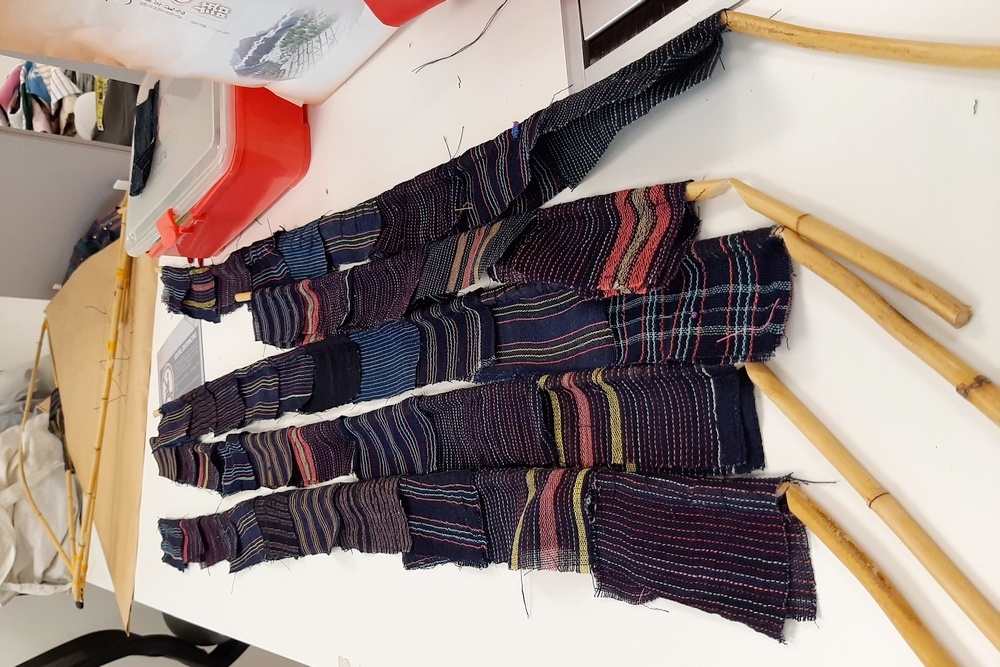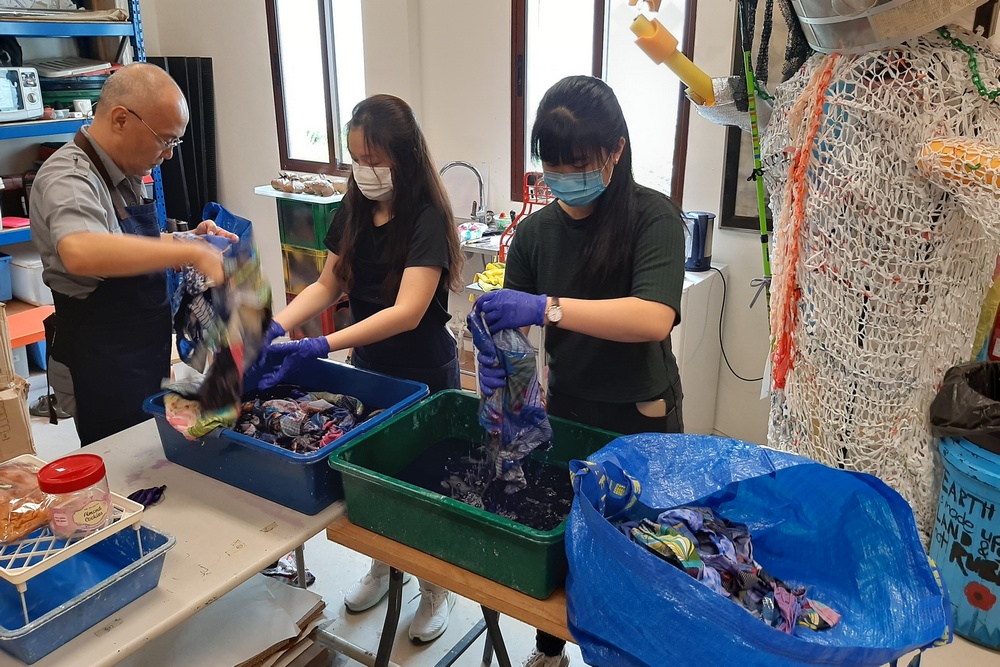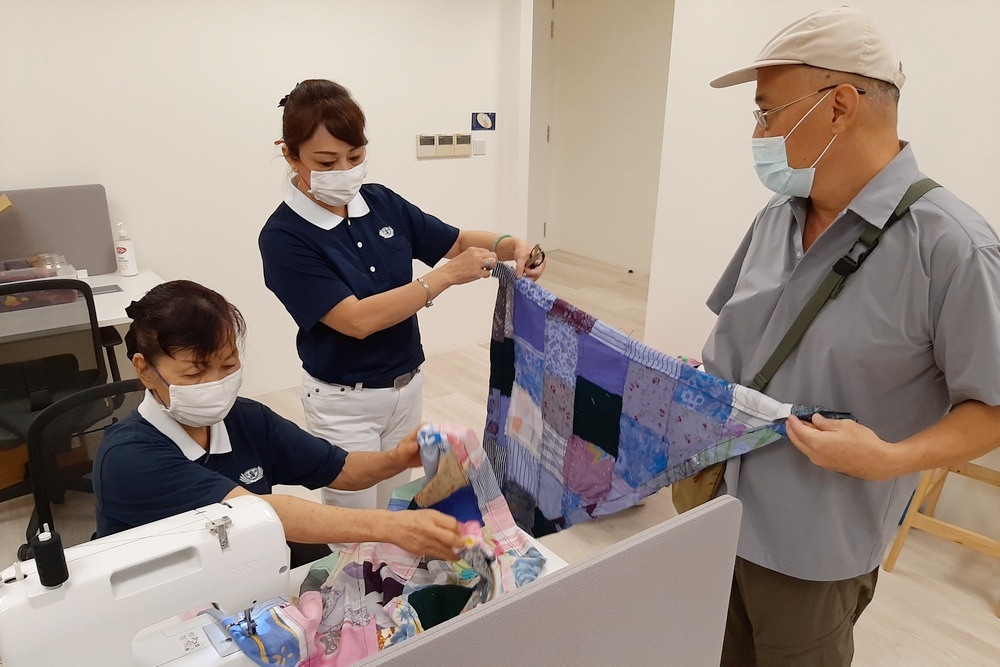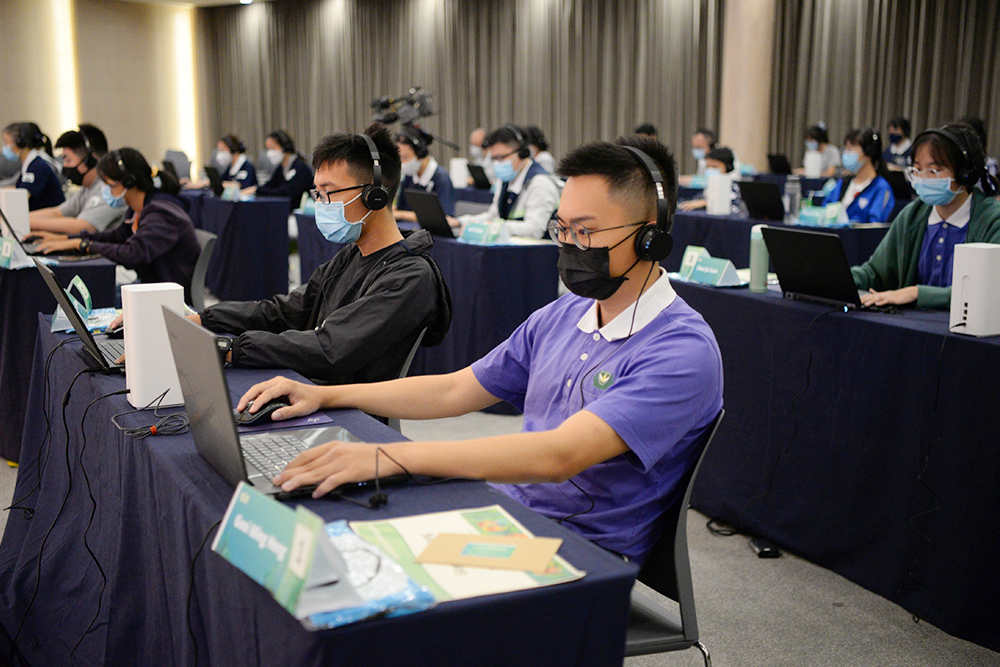 A local artist and several Tzu Chi volunteers spent two months to complete the “Joglo House” together. (Photo by Wong Twee Hee)
A local artist and several Tzu Chi volunteers spent two months to complete the “Joglo House” together. (Photo by Wong Twee Hee)
Singapore’s National Day was celebrated amid a pandemic this year with scaled-down activities to discourage crowd gathering as the nation is still in its Phase 2 of Post-Circuit Breaker. Due to COVID-19, the contributions of migrant workers have been brought to the attention of local residents.
Organized by Tzu Chi Humanistic Youth Centre and 3Pumpkins, and sponsored by Maybank Singapore, the “Stay Home Quilt” art project was officially carried out on 5 June 2020 (note).
Led by local artist, Jimmy Ong from 3Pumpkins, the project aims to connect different community groups in Singapore, including migrant workers who are greatly affected by the pandemic. Jimmy said that migrant workers have built homes for Singaporeans, but local residents and migrant workers rarely have the opportunity to work together in the same space.
"The artistic component of this project is to allow migrant workers and local residents to interact and understand each other," explained Jimmy.
However, the activities carried out at the temporary dormitories are regulated by preventive measures that impose a limitation on the number and age of the participants. To be involved in this meaningful effort to show care and gratitude for these migrant workers, many volunteers had contributed their time and effort in the preparation work before the event.
“Home” redefined
To reflect the various meanings of "home" in relation to migrant workers, the National Day and the pandemic, Jimmy decided to sew 55 triangles into a "home" which represents the 55th anniversary of the founding of Singapore. The fabric works of the migrant workers are hung on both sides of these triangles.
The design of the "home" is based on the structure of the traditional Joglo house found in Java of Indonesia, with its roof shaped like an upside-down rice bowl. The roof is mainly made by Jimmy while the four walls are made of quilts sewn by volunteers using pieces of rags. The structure of the “home” is made using rattans that are wrapped inside the cloth.
There are diverse meanings to this artwork. The “Joglo house” could represent a country, someone’s hometown or even the dormitory which is a temporary home to many migrant workers during the isolation period. The fabric works of the migrant workers are attached onto the fabric works done by volunteers to symbolize joint efforts by migrant workers and local citizens in their contributions to Singapore. To enable visitors to feel the sentiments of the migrant workers, there is also a voice clip inside the “house” which replays the voices of migrant workers sharing about their own fabric work.
The project has made use of large quantities of recyclables which are up-cycled by volunteers and migrant workers into a story telling medium. The rattans which came from the frame of a rattan boat made by another artist, Zai Kuning, were dismantled and given to Jimmy to construct the beams for the “house”.
Collection of secondhand garments from the public
The number of migrant workers with mild symptoms living in the community isolation centre had exceeded 10,000 since late April. Those who checked in in a hurry did not bring enough clothes with them. According to media reports, the public had donated second-hand clothing to hospitals and isolation centres to cover their needs.
After the launching of the “Stay Home Quilt” project, Jimmy and Tzu Chi staff went to Khoo Teck Puat Hospital, which is next door to Tzu Chi Humanistic Youth Centre (HYC) to select suitable second-hand clothing. To collect enough fabric to make 550 sewing kits, HYC had even launched a campaign to collect second-hand clothes online. One of the donors who responded to the call was volunteer Siah Chooi Lan, who donated a large amount of jeans fabric that had helped gather sufficient fabric material for the project.
Siah works in a jeans company and she had spent two years collecting a batch of tailored second-hand pants. Unwilling to discard away the rags, she had wanted to transform these rags into second-hand wallets to be sold during the Chinese New Year Charity Fair next year. Upon learning about the “Stay Home Quilt” project, Siah delightfully said, “These rags can finally be of good use!"
Jimmy had chosen three distinct fabrics from different cultures to highlight his concern for the working class through the art project, these fabrics are lurik, quilt and jeans.
Lurik, which is used to make the roof of the “home”, is the traditional fabric of the working class in Java’s rural areas. While quilt which is used to make the walls of the “houses” symbolizes the wisdom of Chinese women who cherish resources and work hard. Last but not least, jeans were worn by American laborers in the old days, and thus it is used as the main fabric for the artwork.
 The production of floral cloth and quilt requires a lot of equal size rags with different patterns, and the selection and sewing of the rags are very time consuming. (Photo by Bernard Ng Jia Han)
The production of floral cloth and quilt requires a lot of equal size rags with different patterns, and the selection and sewing of the rags are very time consuming. (Photo by Bernard Ng Jia Han)
 A volunteer is “standardizing” the length of the jeans to ensure that the size of the fabric materials to make the sewing kit is the same. (Photo by Bernard Ng Jia Han)
A volunteer is “standardizing” the length of the jeans to ensure that the size of the fabric materials to make the sewing kit is the same. (Photo by Bernard Ng Jia Han)
A joint artwork by different community groups
During the two-month preparation process, different volunteers had to sew the sewing kits and several quilts, support the fabric with rattans, disinfect the fabric works, erect the home structure and hang the fabric works sewn by migrant workers and local residents onto the structure.
Jimmy was there to accompany the volunteers throughout the preparation period to listen to their opinions and discuss the details of the project with them. At the same time, he also encouraged the volunteers to be creative and incorporate their own ideas into their work. With the integration of different ideas from all parties, the finished product was constantly adjusted during the completion process and it was not finalized until early August.
We are all in the same boat
Volunteers who participated in the preparation work had been in touch with Tzu Chi through the fabric face mask donation project. The “Stay Home Quilt” art project is a continuity of the face mask project to keep them contributing through sewing. Due to age limit, some elderly volunteers are are not permitted to participate in the art project as they do not meet the age limit requirement under the epidemic prevention measures, therefore, those senior volunteers contributed more actively in the mask sewing project. On the other hand, Tzu Chings seized their school break opportunity to participate in the sewing session held at the dormitory.
National University of Singapore undergraduate, Melissa who hails from Indonesia appreciates the opportunity to be able to participate in this special project as the ongoing pandemic has prevented her from going home during school break. Therefore, she and a few other Indonesian students had regularly volunteered for this project every week.
Melisa found this project to be different from the usual aid relief distribution activities as this project took care of the mental well-being of the migrant workers. She said, “From what I heard from my family, the volunteering activities they are involved in are mostly making masks for those who can’t afford to buy masks. I have never heard of any (Tzu Chi activities) that touches on arts and (mental) well-being (of the recipients), it is a very good project to have here.”
With almost zero experience in sewing, Melisa shared, "I have not done much sewing before, sewing calms my mind and distracts me from anxiety, especially when one is cooped up alone in the room,” said Melissa.
Winy Febriny Indayang who also came from Indonesia said that she is luckier than the migrant workers despite sharing the same fate of not being able to fly home during holidays. She also appreciates the opportunity to be able to do something for the migrant workers during this period of time.
To comply with preventive measures, most volunteers and members of the public are not able to communicate and interact face-to-face with migrant workers. But through this art project, migrant workers, housewives, working class people, artists, and students have “built a home" together.
The “Stay Home Quilt” has been on display at Tzu Chi Humanistic Youth Centre since National Day. HYC is also planning to hold a large-scale exhibition with the theme of migrant workers at the end of November this year.
 Melissa (left) and Winy Febriny Indayang (right) from Indonesia are helping with the preparation work every week. (Photo by Wong Twee Hee)
Melissa (left) and Winy Febriny Indayang (right) from Indonesia are helping with the preparation work every week. (Photo by Wong Twee Hee)
 The fabric work made by migrant workers and local residents are attached to the surrounding of the “house”. (Photo by Chong Yu Jia)
The fabric work made by migrant workers and local residents are attached to the surrounding of the “house”. (Photo by Chong Yu Jia)
Note:
The lead artist of this project is Jimmy Ong. The project is organized by Tzu Chi Humanistic Youth Centre and 3Pumpkins, sponsored by Maybank Singapore, and supported by Singapore International Foundation, The Majurity Trust, PAssionArts in Nee Soon GRC, Chong Pang Community Arts & Culture Club, and Nee Soon East Community Arts & Culture Club.








